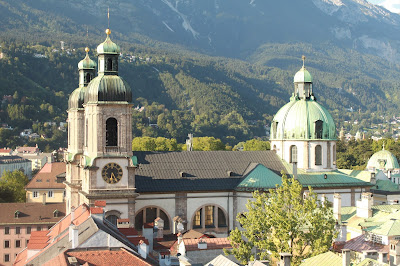Innsbruck is a town I visited several times during our 4 year stint in Vienna from 1985 to 1989. I then visited this pretty Alpine Austrian town in 2008 and then again in 2011. Set in a valley surrounded by the Austrian Alps, Innsbruck in a lovely town having close to 130,000 inhabitants, and it is the capital of the Austrian state of Tyrol.
Innsbruck dates back to the 12th century AD. It was a major trading centre in the middle
ages. It served as a main center of power for the Habsburg rulers of Austria, as the Holy Roman Emperor, Maximilian I, choose to reside there in the 1490's. In 1564, the Archduke of Austria, Ferdinand II, got control over Tyrol. Until 1655, branches of the Habsburg family ruled in Innsbruck with an independent court. During the Napoleonic Wars, Tyrol became a part of Bavaria, and continued to be so till 1814. It then became a part of the Austrian monarchy, until its fall in 1918.
The Dom St Jakob is a cathedral that was built in Baroque style in 1724.
It was damaged in WW II and needed to be rebuilt in the 1950's. The cathedral has a lavish interior, and a large dome. The font facade has 2 bell towers. The cathedral has a famous painting, Lucas Cranach's Maria Hilf. It also has the Tomb of Maximilian III.
 |
| Dom St Jakob |
 |
| Ceiling Frescoes, Dom St Jakob |
 |
| High Altar, Dom St Jakob |
 |
| Pulpit, Dom St Jakob |
 |
| Sacred Heart, Dom St Jakob |
 |
| Pieta, Dom St Jakob |
The Goldenes Dachl, or
Golden Roof, is where Emperor Maximilian I used to stand and observe the
town’s activities. The building houses an interesting museum depicting the life
and times of the Emperor and his two wives, Maria of Burgundy and Bianca Maria
Sforza. The roof has numerous gilded copper tiles, that appear golden in colour, and
hence the name. The balcony has some interesting coats of arms from that
period. There is a nice view of Friedrichtrasse, the town's main pedestrian street, from Goldenes Dachl, though
the balcony is netted to keep pigeons out.
 |
| Goldenes Dachl |
 |
Friedrichstrasse, with the Goldenes Dachl
and the Stadtturm |
The Stadtturm has a viewing gallery at the summit. The tower is 56 meters high and was
completed in 1560. It stands close to the Goldenes Dachl and lies on Friedrichstrasse.
 |
| The Stadtturm |
The Hofkirche was built by Emperor Ferdinand I as a memorial to his
grandfather Maximilian I, who was the Habsburg Emperor from 1493 to 1519. The
tomb was designed by Maximilian I
himself in his lifetime. For the last 5 years of his life, Maximilian I traveled
everywhere with his coffin. He was badly injured in a fall from a horse in 1501
and he never fully recovered. The church was finally completed in 1587. Maximilian
I’s son was Philip the Handsome, but he died young in 1506. Charles V,
Maximilian I’s grandson, succeeded him on the throne after his death in 1519. Ferdinand I was Charles V’s brother and he took over the throne after his abdication.
 |
| Hofkirche |
 |
| Maximilian I's Memorial, Hofkirche |
 |
| Painting of the Dying Maximilian I, Hofkirche |
 |
| Sculpture of Albert I, Hofkirche |
 |
| Crucifixion, Hofkirche |
The Jesuiten Kirche is one of
Innsbruck’s prettiest churches, and stands out with its large dome and twin
bell towers. The church was consecrated in 1646. It was badly damaged in WW II
and needed extensive renovation.
 |
| Jesuiten Kirche |
 |
| Nave, Jesuiten Kirche |
 |
| Crucifixion, Jesuiten Kirche |
 |
| The Annunciation, Jesuiten Kirche |
The Hofburg dates back to the 15th century
when Archduke Sigmund started construction. However, re-modelling took
place in 1755 under the reign of the Habsburg Empress, Maria Theresia. The
interior of the palace has beautiful furnishings and decorations, as well as
paintings of Maria Theresia and her sixteen children.
 |
| The Hofburg |
Helblinghaus is an impressive work
of architecture on Friedrichstrasse. This building was
decorated in 1725 in an opulent Rococo style.
 |
| Helblinghaus |
With its picturesque mountainous setting, its spectacular baroque churches and its charming pedestrian streets, Innsbruck is one of the prettiest towns in Austria. The town is also a preferred location for winter sports, and 2 Winter Olympics have taken place there, in 1964 and 1976. After Vienna and Salzburg, if I had to recommend another place in Austria, it would certainly be this beautiful town!




















No comments:
Post a Comment